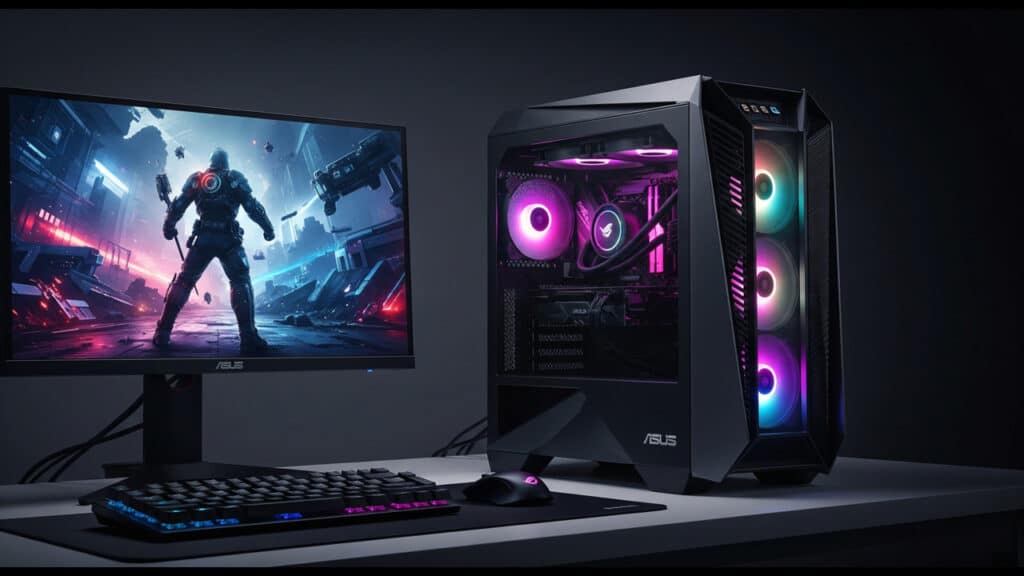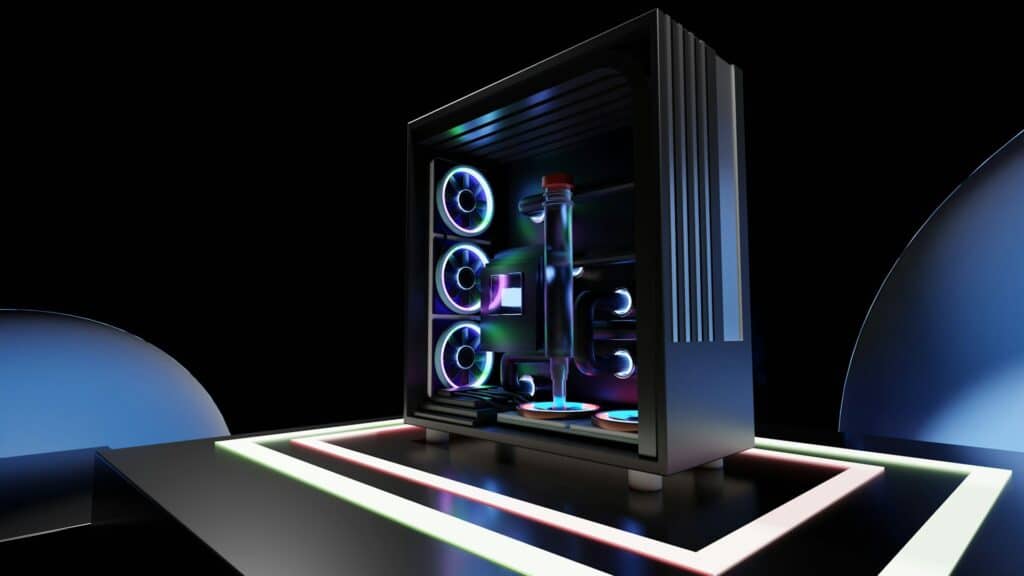
Table of Contents
Introduction
In the electrifying, ever-evolving world of PC gaming, the pursuit of the ultimate rig is a journey many enthusiasts embark on. From the crisp, high-fidelity graphics that pull you into fantastical realms to the lightning-fast frame rates that give you a competitive edge, your gaming PC is the beating heart of your virtual adventures. As games become more demanding and experiences more immersive, the need for a powerful, reliable, and future-proof machine has never been greater.
When it comes to crafting top-tier gaming hardware, one name consistently rises above the rest: ASUS. Renowned for its unwavering commitment to quality, groundbreaking innovation, and a deep understanding of gamers’ needs, ASUS has solidified its reputation as a leader in the industry. Their Republic of Gamers (ROG) series, in particular, has become synonymous with cutting-edge performance, superior cooling, and features designed specifically to elevate your gaming experience. Choosing an ASUS tower PC isn’t just buying a computer; it’s investing in a legacy of gaming excellence.
Navigating the vast landscape of gaming PCs can be daunting, especially with ASUS’s diverse and impressive lineup of tower systems. This comprehensive guide “best ASUS tower PC for gaming”, is designed to be your ultimate resource, helping you cut through the noise and pinpoint the ideal ASUS tower PC for your specific gaming ambitions. We’ll delve into various models, highlight their strengths, and ultimately empower you to make an informed decision that will bring your gaming dreams to life.
Understanding ASUS’s Gaming Tower PC Lines
ASUS offers a compelling range of gaming tower PCs, each meticulously designed to deliver an exceptional gaming experience. From battle-hardened veterans to budget-conscious newcomers, there’s an ASUS gaming PC tailored to your needs. Their primary lines, ROG (Republic of Gamers) and TUF Gaming, represent distinct philosophies in performance, aesthetics, and value. Understanding these series is crucial for making an informed decision about your next gaming rig.
ROG Strix Series
- Target Audience: The ROG Strix series is engineered for a broad spectrum of gamers, appealing to both mainstream players seeking a solid upgrade and high-end enthusiasts demanding powerful performance without breaking the bank.
- Key Features: Strix PCs strike an excellent balance between raw power, appealing aesthetics, and competitive pricing. They often feature efficient air cooling or liquid cooling options for optimal thermal management, ensuring stable performance during intense gaming sessions. Expect stylish chassis designs with customizable RGB lighting.
- Examples of current/recent models: Look out for models like the ROG Strix G15 and ROG Strix G35, which consistently offer a strong mix of the latest CPUs and GPUs.
ROG Huracan / ROG Gxx Series (or equivalent high-end)
- Target Audience: This tier is built for the uncompromising enthusiast and competitive gamer who demands nothing less than bleeding-edge performance. These machines are designed for those who want to push frames to the absolute limit and experience games at their highest settings.
- Key Features: Expect top-tier, often overclockable, CPUs and the most powerful GPUs available. These systems incorporate advanced cooling solutions, including sophisticated liquid cooling systems, and premium components for maximum stability and longevity. They often boast unique and aggressive designs that stand out.
- Examples of current/recent models: While the ROG Huracan G21 was a notable example of a compact, high-performance machine, its spirit lives on in more recent high-end ROG Gxx series desktops, such as the ROG G35DX/CX models, which embody the pinnacle of ASUS’s gaming desktop offerings.
TUF Gaming Series
- Target Audience: The TUF Gaming series is specifically designed for value-conscious gamers who prioritize durability, reliability, and excellent performance-to-price ratio. These PCs are built to withstand the rigors of extended gaming sessions.
- Key Features: TUF Gaming PCs are known for their robust build quality and understated, yet functional, aesthetics. While they might forgo some of the flashier RGB elements of the ROG line, they deliver solid gaming performance thanks to well-chosen components. They represent an excellent entry point into PC gaming or a reliable upgrade.
- Examples of current/recent models: The TUF Gaming GT15 and TUF Gaming GT30 are prime examples, consistently offering a strong performance proposition for their price point.
Other Potential Lines
While ROG and TUF Gaming cover the primary gaming tower PC segments, ASUS also offers other lines that may include models with significant gaming capabilities. For instance, certain ProArt workstations, while primarily aimed at content creators, can house powerful GPUs that make them viable for gaming. Similarly, some of ASUS’s more compact PC offerings, while not traditionally “towers,” might offer surprising gaming prowess for niche users seeking a smaller footprint.
Key Components To Look For In An ASUS Gaming PC
Processor (CPU)
The CPU is the heart of your gaming PC. ASUS offers systems with both Intel and AMD processors. For Intel, look towards the Intel Core Ultra Series or the latest generation of i5, i7, or i9 chips. On the AMD side, the Ryzen 7000/8000 series (or current generation) offers fierce competition. When gaming, both core count and clock speed are vital. Higher core counts benefit multitasking and certain game engines, while higher clock speeds generally translate to better in-game performance. For budget-conscious gamers, an i5 or Ryzen 5 might suffice for 1080p gaming, whereas an i7/Ryzen 7 or i9/Ryzen 9 is ideal for high refresh rate 1440p or 4K gaming and future-proofing.
Graphics Card (GPU)
For gaming, the GPU is arguably the most critical component. You’ll primarily find ASUS systems featuring either NVIDIA GeForce RTX 50 Series (or current generation 40 Series) or AMD Radeon RX 8000/9000 Series (or current generation) graphics cards. Key specifications to consider include VRAM (Video RAM), which dictates the amount of graphical data the card can handle, crucial for higher resolutions and texture settings. Features like ray tracing capabilities offer incredibly realistic lighting and reflections, while NVIDIA’s DLSS and AMD’s FSR are AI-powered upscaling technologies that boost frame rates without a significant loss in visual quality. GPUs come in tiers, influencing the resolution and frame rates you can achieve. Entry-level cards might be suitable for 1080p gaming, mid-range for smooth 1440p, and high-end cards are essential for demanding 4K gaming.
RAM (Memory)
RAM directly impacts your system’s ability to handle multiple applications and game assets simultaneously. DDR5 is the current standard, offering significant speed improvements over older DDR4. While DDR4 might still appear in some budget builds, DDR5 is highly recommended for optimal performance. Aim for a minimum of 16GB of RAM, but 32GB is ideal for future-proofing and ensuring smooth performance in memory-intensive games and multitasking scenarios. Also, pay attention to the clock speed (MHz) of the RAM, as higher speeds contribute to better overall system responsiveness.
Storage
For rapid boot times and lightning-fast game loading, an NVMe SSD is non-negotiable. Look for PCIe Gen 4 as a minimum for your primary drive, with Gen 5 being even faster if available and within budget. The significant speed difference an SSD offers over traditional hard drives dramatically improves the gaming experience. While an SSD is crucial for your operating system and frequently played games, a secondary HDD for mass storage might be a cost-effective option if you have a vast game library or large media files.
Cooling System
High-performance components generate heat, and effective cooling is vital for sustained performance and the longevity of your PC. You’ll typically find systems employing either robust air cooling solutions or more advanced liquid cooling (AIOs – All-in-One). Adequate cooling prevents thermal throttling, ensuring your CPU and GPU can maintain their boost clocks. ASUS often integrates its own impressive cooling solutions, such as their ROG AIOs, designed to efficiently dissipate heat from high-end components.
Power Supply Unit (PSU)
Often overlooked, the Power Supply Unit (PSU) is critical. Ensure the PSU has sufficient wattage to power all your components, with some headroom for future upgrades. An 80 Plus certification (Bronze, Gold, Platinum, Titanium) indicates the PSU’s efficiency in converting AC power to DC power, leading to less wasted energy and heat. Choosing a higher wattage and efficiency-rated PSU also provides peace of mind for potential GPU upgrades down the line.
Top ASUS Tower PC Recommendations For Gaming
When it comes to gaming, ASUS consistently delivers powerful and reliable tower PCs that cater to a wide spectrum of players. From budget-conscious beginners to competitive esports enthusiasts and content creators, there’s an ASUS desktop designed to meet your needs. While specific model names evolve, the underlying philosophy of performance, design, and value remains. Here’s a breakdown of our top ASUS tower PC recommendations, categorized by budget and performance tiers.
Best Budget-Friendly ASUS Gaming PC
For those dipping their toes into the world of PC gaming or looking for a solid machine for esports and casual titles, a budget-friendly ASUS option is a fantastic starting point. These PCs are designed to offer excellent value without compromising on the essential gaming experience.
- Model Name Placeholder: ASUS TUF Gaming G10 Series (e.g., TUF Gaming G10CE or similar current-gen entry)
- Key Specs (Representative): You can typically expect a capable Intel Core i5 or AMD Ryzen 5 processor, paired with a discrete graphics card like an NVIDIA GeForce RTX 3050 or AMD Radeon RX 6600. RAM usually hovers around 8GB or 16GB of DDR4, with a 512GB NVMe SSD for fast boot times and game loading.
- Ideal for: This tier is perfectly suited for smooth 1080p gaming, especially for popular esports titles like Valorant, CS2, League of Legends, and Fortnite. It also handles many AAA titles at playable frame rates with adjusted settings, making it great for casual gamers who enjoy a variety of genres.
- Pros & Cons:
- Pros: Excellent value for money; reliable performance for 1080p gaming; good upgrade potential for future enhancements; often features robust cooling for its class.
- Cons: May struggle with demanding AAA titles at max settings; limited future-proofing for resolutions beyond 1080p; sometimes features more basic chassis designs.
Best Mid-Range ASUS Gaming PC
The mid-range is where ASUS truly shines, offering a balance of performance, features, and price that caters to the majority of serious gamers. These machines are built to deliver a premium 1440p gaming experience and high refresh rates at 1080p.
- Model Name Placeholder: ASUS ROG Strix G15CF Series (e.g., ROG Strix G15CF or current mid-tier ROG Strix model)
- Key Specs (Representative): Expect powerful processors like an Intel Core i7 or AMD Ryzen 7, coupled with a formidable GPU such as an NVIDIA GeForce RTX 4060 Ti or RTX 4070, or an AMD Radeon RX 7700 XT/7800 XT. RAM typically starts at 16GB DDR4 (or increasingly DDR5), often with a 1TB NVMe SSD.
- Ideal for: This category is the go-to for enthusiasts seeking fluid 1440p gaming across most AAA titles, high refresh rate competitive play at 1080p, and even entry-level content creation tasks like video editing or streaming.
- Pros & Cons:
- Pros: Excellent performance for the price; capable of high refresh rate gaming; often features stylish ROG aesthetics and better cooling solutions; good balance of CPU and GPU power.
- Cons: Can be a significant investment; some models might have limited expandability if form factor is compact; potentially higher power consumption than budget models.
Best High-End ASUS Gaming PC
For the ultimate gaming experience, where frame rates are paramount and graphical fidelity is uncompromised, ASUS’s high-end offerings represent the pinnacle of desktop performance. These machines are designed for 4K gaming, virtual reality, and demanding professional workflows.
- Model Name Placeholder: ASUS ROG G22CH / ROG Huracan Series (e.g., ROG G22CH, ROG Huracan G21, or other flagship ROG desktop)
- Key Specs (Representative): These beasts pack the latest and greatest processors, such as an Intel Core i9 or AMD Ryzen 9, alongside top-tier GPUs like an NVIDIA GeForce RTX 4080 SUPER or RTX 4090, or an AMD Radeon RX 7900 XTX. RAM will be 32GB or 64GB of high-speed DDR5, with multiple NVMe SSDs (1TB primary, plus additional storage options). Advanced cooling solutions, including AIO liquid coolers, are standard.
- Ideal for: Unrivaled 4K gaming at max settings, competitive gaming on high refresh rate 4K monitors, seamless virtual reality experiences, professional-grade content creation (3D rendering, complex video editing, game development), and serious multi-tasking.
- Pros & Cons:
- Pros: Absolutely top-tier gaming and workstation performance; future-proof for several years; premium build quality and advanced cooling; stunning aesthetics and often unique designs.
- Cons: Very high price point; significant power consumption and heat generation; may require larger desk space due to size; less focus on “value” and more on ultimate performance.
Runner-Up / Niche Pick
Sometimes, the best solution isn’t just raw power but also clever engineering and form factor. ASUS offers unique options for those who need high performance in a more discreet or specialized package.
- Model Name Placeholder: ASUS ROG G22CH (Compact High-Performance Option)
- Key Specs (Representative): While often housing similar internal components to a mid-to-high-range desktop (e.g., Intel Core i7/i9, NVIDIA GeForce RTX 4070/4080), the G22CH (or similar compact models) differentiates itself by fitting these powerful components into a significantly smaller chassis, often around 10-12 liters in volume.
- Why it Stands Out: The G22CH excels in delivering robust gaming performance within a compact footprint. Its innovative thermal design, often featuring a multi-chamber setup and custom airflow, allows it to keep powerful components cool despite its size. It’s perfect for gamers with limited desk space, those who prefer a minimalist setup, or even LAN party enthusiasts who need a portable powerhouse.
- Pros & Cons:
- Pros: Extremely compact and space-saving; unique and stylish design; often features advanced cooling for its size; surprisingly powerful for its footprint.
- Cons: More difficult to upgrade components due to custom layout; can be more expensive than similarly specced larger towers; thermal performance, while good for its size, won’t match a large tower.
Factors To Consider Before Buying
When investing in a gaming PC, especially an ASUS tower, thoughtful consideration of several factors will ensure you make the best choice.
- Budget: Your budget is paramount. While it’s tempting to aim for the top-tier, define a realistic spending limit. This will help narrow down options and prevent overspending, ensuring you get the most performance for your money without breaking the bank.
- Your Gaming Habits: This is crucial for hardware selection. Are you a casual gamer playing indie titles, or do you crave the latest AAA blockbusters at 4K resolution and high frame rates? Understanding your gaming preferences will dictate the necessary GPU and CPU power.
- Future-Proofing: Technology evolves rapidly. Opt for a PC that allows for future upgrades of key components like RAM, storage (SSD/HDD), and especially the GPU. This extends the PC’s lifespan and keeps you competitive without needing a whole new system every few years.
- Connectivity: Consider your peripherals and display setup. Ensure the PC has sufficient USB ports for all your accessories, and the appropriate video outputs (HDMI, DisplayPort) for your monitor(s). Reliable Wi-Fi and a strong Ethernet port are also essential for online gaming.
- Software & Bloatware: Some pre-installed software can be beneficial, but excessive “bloatware” can hog resources. Research what comes pre-loaded and how easy it is to remove unwanted programs to ensure a clean and efficient gaming experience.
- Warranty & Support: Even the best hardware can encounter issues. Investigate ASUS’s warranty policies and their reputation for customer support. Knowing you have reliable assistance in case of a problem provides peace of mind.
Conclusion
Choosing the ideal gaming rig is a significant decision, and as we’ve seen, selecting the right ASUS tower PC is paramount to unlocking an exceptional gaming experience. From competitive esports to immersive AAA titles, the hardware you choose directly impacts your performance and enjoyment.
Fortunately, ASUS stands out with its incredibly diverse range of gaming tower PCs. Whether you’re a casual gamer on a budget, a hardcore enthusiast seeking cutting-edge performance, or a content creator needing serious processing power, ASUS offers a solution tailored to your specific needs and financial considerations. With their commitment to innovation and quality, you can be confident in finding a system that delivers.
Ultimately, the best ASUS gaming PC is the one that aligns perfectly with your individual requirements. Consider your preferred games, desired performance levels, budget, and any future upgrade plans. By taking these factors into account, you’ll be well-equipped to make an informed decision and invest in a machine that will elevate your gaming for years to come.


